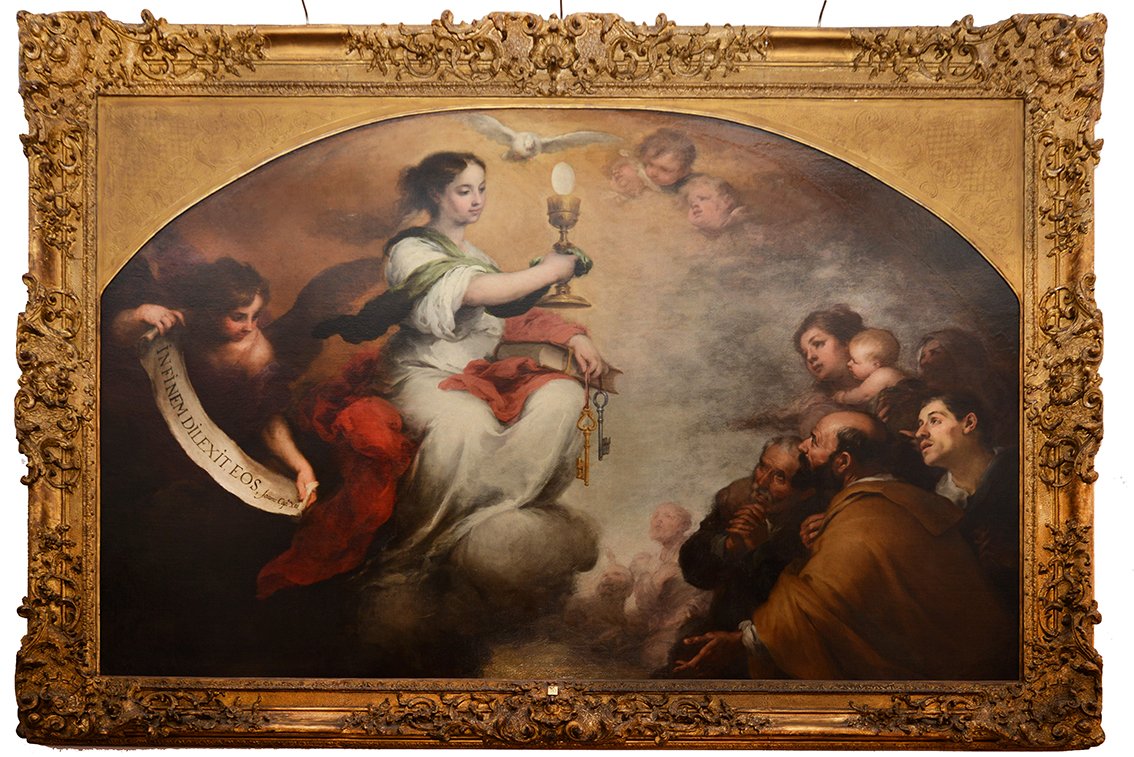
Faith or the Church Triumphant
1617-82
Oil on canvas, lunette, (subsequently made rectangular) 64 3/8 ins by 98 5/8 ins.(the latter including an added slip o/d 1 1/8 ins).
Collection Details
One of the set of four lunettes commissioned before 1665 by Murillo’s friend, Canon Justino de Neve, for the church of Santa María la Blanca in Seville, which was finished in 1665 and for which he was prebendary. All four were removed during the Spanish War of Independence (1808–14) and taken as war booty to France by Marshal Soult. The two larger ones were intended for the Musée Napoléon in Paris or the proposed museum in Madrid, and in 1814 were on exhibition in Paris (cf Notice des Tableaux exposés … Musée Royal, Paris, 1814, p.73, Nos. 83, 84). After the Peace, these two pictures were returned to Spain (see below); of the remaining two, the Immaculate Conception, which is now in the Louvre, is said to have been bought by Louis XVIII in 1817 from a M. Lom; and the Triumph, which appears to have passed to General Faviers, later entered the Pourtalès collection; Comte de Pourtalès sale, Paris, 27 March 1865, lot 199; Mrs Lyne Stephens by 1891; her sale, Christie’s, 11 May 1895, lot 324: bt by Agnew, who sold it to Alexander Henderson, 1st Lord Faringdon, the same year; included in the latter’s sale, Sotheby’s, 13 June 1934, lot 146, repd, when it was bought back by Lord Faringdon.
Literature
Torre Farfán, Fiestás que celebro la Iglésia de S. M. la Blanca, 1666; A Ponz, Viaje de España, 1785, ix (1947 edn, p.783); D J A Céan Bermúdez, Diccionario Historico, 1800, ii, pp.58–9; F González de Léon Noticia Artistica, 1844, i, pp.102–4; Sir W Stirling-Maxwell, Annals of the Artists in Spain, 1848, ii, pp.844–6; C B Curtis, Velasquez and Murillo, 1883, p.207, No.231; A L Mayer, Murillo (Klassiker der Kunst), 1913, 1923, p.xi; idem, ‘Ausstellung … Grafton Galleries’, Zeitschrift für Bildende Kunst, N F, 1914, pp.8, repd, 10, No.25; G Kubler and M Soria, Art and Architecture in Spain and Portugal, 1959, p.274; Angulo Iñíquez, ‘Las Pinturas de Murillo, de Santa María la Blanca’, Archivo Español de Arte, 165, 1969, pp.30–1, repd pl.14; Gaya Nuño, L’opera completa di Murillo, 1978, No.106; E Young, Die Grosse Meister der Malerei: Bartolomé Murillo, 1980, No.110; Angulo Iñíquez, Murillo, 1981, No.42.
Exhibition Details
RA, Winter, 1891, No.114; 1896, No.116; BFAC, 1908, No.16; Grafton Galleries, London, Spanish Old Masters, 1913, No.79; RA, Winter, Spanish Painting, 1920, No.85; Agnew, London, The 17th Century, 1960, No.17; National Gallery, El Greco to Goya, 1981, No.50; Prado and RA, Murillo, 1982–3, No.39.
Companion Pictures
The three other pictures belonging to the series are The Dream of the Roman Patrician (Prado, No.994); The Roman Patrician before Pope Liberius (Prado, No.995); and The Immaculata (Louvre, No.1708). These, but not the present picture, are repd by Mayer (op cit, 1913, 1923, pp.77, 78, 76). The two pictures now in the Prado were placed originally under the crossing of Santa María la Blanca, while the Louvre picture and the picture now at Buscot hung nearby in the aisles.
Background
Together, the four pictures celebrate the Church and the Virgin Mary, and the foundation of S Maria Maggiore in Rome, the mother church of Santa María la Blanca, through the miraculous intervention of the Virgin. The legend has it that she appeared in a dream to both the patrician John and Pope Liberius (352–66) to tell them to build a church in her honour (the only early basilica so dedicated) on the Esquiline Hill. When they met there the next day (5 August), they found its plan miraculously marked out by a fall of snow – hence the Virgin’s title ‘Our Lady of the Snows’. That nieve in Spanish – or neve in Portuguese – means ‘snow’ can hardly have failed to influence de Neve’s choice of dedication (‘St Mary the White’) and imagery.
The church was built following Pope Alexander VII’s papal brief of 1661, which reaffirmed the doctrine of the Immaculate Conception, and particularly extolled Seville’s devotion to this mystery (celebrated in the Louvre painting). The present picture proclaims the other great Catholic dogma, that of the Real Presence, or transubstantiation. A figure with a book and keys (symbols of St Peter, the first ‘Pope’), representing the Church, holds aloft a chalice and host to celebrate the Eucharist. The dove of the Holy Ghost hovers above (signifying the presence of God in these), to be adored by Cherubim and the Faithful.
The inscription – IN FINEM DILEXIT EOS. Joanis Cap.e XIII (‘he loved them unto the end’) – comes from the first verse of the chapter in St John’s Gospel in which Christ institutes the Eucharist. It was by promising his continuing presence in the sacrament at the Last Supper that he manifested his love for mankind to the end. This inscription is answered by another in the Louvre picture – IN PRINCIPIO DILEXIT EAM (‘He loved her from the beginning’) – identifying the Virgin with the Church as the source of salvation.
A date of between 1662 and 1665 is usually accepted for the four pictures. In the latter year, the conversion of the medieval synagogue into a baroque church was completed, and in the following year Murillo’s work was described by Torre Farfán.
The Trustees of the Faringdon Collection 25.
All rights reserved.
